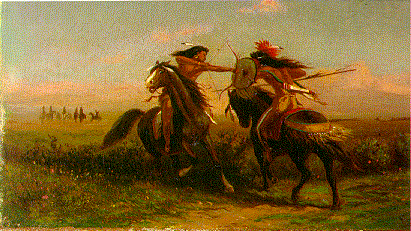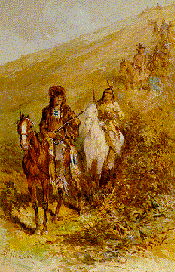Native Americans of Knox County
 The First Farmers of Knox County: The Adena Indians
The First Farmers of Knox County: The Adena Indians
Native Americans first appeared in Knox County around 11,000 B.C.
It was not until the time of the Adena culture, around 1,000 B.C.,
that agriculture was introduced to the area. The Adena Indians used tools
made of stone, animal bones and tortoise shell to grow crops of squash,
pumpkins, gourds, sunflowers, and maize.
 Kenyon Professor, Nick Kardulias, describes Adenan farming practices:
Kenyon Professor, Nick Kardulias, describes Adenan farming practices:
What they depended on were a variety of native plants that provided relatively
small seeds; chenopodium and a variety of amaranth and other things like that.
And sunflower. And they planted these things in what we assume were relatively
small gardens and harvested those things on a regular basis. They were situating
themselves in a location where they could do farming but also would be able to go up
into the hills to take some wild game and probably also a variety of different
plants that would be available.
The White Oak Inn, which was once the homestead of the Crise family, and is now a
bed and breakfast, helps to preserve the farming history of Knox County.
Located in the notheast corner of Butler Township, the Inn is now owned by Ian
and Yvonne Martin. The Inn is located next to an official archeological site, which shows
evidence of occupation by Native American farmers dating
back to prehistoric times. The White Oak Inn reminds people not only of the inhabitants
of the past century, but also of the Americans who worked the land long before the
first European settlers in Ohio.

 The Last Native Americans in Knox County
The Last Native Americans in Knox County
The agriculture practiced by the Ohio Native Americans of the 18th century combined methods conceived by the
Adena culture, as well as new aspects which were products of white.
White settlers were amazed by the high rate of cultivation on the farms of these people. This
was particularly remarkable considering the hardships which they endured -constant displacement due to incoming waves of white settlers demanding the land.
Men and women worked together to clear the land by girdling trees. This
process included cutting through the bark and then leaving the trees to
stand until later years when they would die and could then be easily cleared.
The tribes would abandon the land they were on every five to ten years
despite the difficulties of land clearing, because they believed that
overuse of land would cause soil exhaustion. This method is perhaps the first
form of rotational farming in the area.
This already cleared and abandoned land attracted many of the first white settlers.
Corn was the largest crop of the Ohio Indians.
They planted their corn in May, corresponding with the blooming of
the hazels. The Indians first soaked the kernels in water, and then
planted them in holes three of four feet apart.
The corn was stored in caches in the earth. Other crops included beans, nuts,
and wild fruits.
Prior to the arrival of white settlers, the only tools which the Indians of this area had were
stone hatchets, pointed sticks, and bone shovels and hoes. After the settlers arrived
the Indians quickly began to adopt their tools.
By 1825, many of the Indians had been removed from Knox County and by 1842 they were almost entirely pushed out of the
area.
artwork credits: William M. Cary, Paul Frenzeny


 E-Mail The Family Farm Project
E-Mail The Family Farm Project The First Farmers of Knox County: The Adena Indians
The First Farmers of Knox County: The Adena Indians The First Farmers of Knox County: The Adena Indians
The First Farmers of Knox County: The Adena Indians Kenyon Professor, Nick Kardulias, describes Adenan farming practices:
Kenyon Professor, Nick Kardulias, describes Adenan farming practices:

 The Last Native Americans in Knox County
The Last Native Americans in Knox County


 E-Mail The Family Farm Project
E-Mail The Family Farm Project